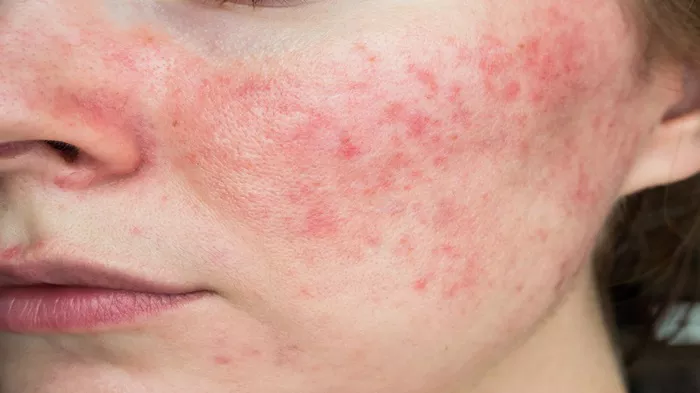Facial allergic reactions can be frustrating and uncomfortable, affecting not only our appearance but also our overall well-being. From redness and itching to swelling and rash, these reactions can manifest in various forms, making it challenging to pinpoint the exact cause. In this comprehensive article, we explore the reasons behind recurring allergic reactions on the face, identifying common triggers and offering practical solutions to manage and prevent them effectively.
Understanding Allergic Reactions on the Face
What are Allergic Reactions?
Allergic reactions occur when the immune system overreacts to a substance (allergen) that is typically harmless. When exposed to an allergen, the body releases chemicals like histamine, leading to inflammation and the characteristic symptoms of an allergic reaction. These symptoms can vary widely depending on the individual’s sensitivity and the type of allergen involved.
Facial Allergic Reactions
Facial allergic reactions specifically refer to allergic responses that affect the skin, mucous membranes, or other tissues of the face. Common symptoms include:
Redness
Itching or burning sensation
Swelling (angioedema)
Rash or hives
Dry, flaky skin
Bumps or blisters
These reactions can occur anywhere on the face, including the cheeks, forehead, nose, lips, and around the eyes.
Common Causes of Facial Allergic Reactions
Skincare Products
Skincare products, including cleansers, moisturizers, serums, and makeup, can contain ingredients that trigger allergic reactions. Common allergens found in skincare products include fragrances, preservatives (such as parabens), dyes, and certain chemicals (e.g., formaldehyde releasers). Even products labeled as “natural” or “hypoallergenic” may contain allergenic ingredients.
Cosmetics and Hair Products
Makeup, hair dyes, and styling products can also cause allergic reactions on the face. Ingredients like fragrances, dyes, and preservatives are common culprits. Additionally, certain hair dyes contain paraphenylenediamine (PPD), a potent allergen known to cause severe allergic reactions, including facial swelling and blistering.
Environmental Allergens
Outdoor and indoor allergens can trigger allergic reactions when they come into contact with the face. Pollen, dust mites, pet dander, mold spores, and certain plants can all cause facial symptoms in sensitive individuals. Outdoor allergens may adhere to the skin or be inhaled through the nose and mouth, while indoor allergens can accumulate on surfaces and in the air.
Food Allergies
Food allergies can manifest as facial allergic reactions, particularly if the allergenic food comes into contact with the face. Common food allergens include nuts, shellfish, dairy, eggs, soy, and wheat. Ingesting or touching these foods can lead to symptoms such as itching, swelling, and hives around the mouth and lips (oral allergy syndrome).
Medications
Some medications can cause allergic reactions on the face as a side effect. Antibiotics (such as penicillin and sulfa drugs), nonsteroidal anti-inflammatory drugs (NSAIDs), and certain skincare medications (e.g., retinoids) are known to cause allergic skin reactions. Reactions can range from mild redness and itching to severe swelling and blistering.
Contact Dermatitis
Contact dermatitis is a type of allergic reaction that occurs when the skin comes into direct contact with an allergen or irritant. Allergens like metals (e.g., nickel), latex, and topical medications (e.g., neomycin) can trigger contact dermatitis on the face, leading to redness, itching, and rash.
Identifying and Managing Facial Allergies
Patch Testing
Patch testing is a diagnostic tool used to identify specific allergens that may be causing facial allergic reactions. During patch testing, small amounts of potential allergens are applied to the skin on the back and covered with patches. After a few days, the patches are removed, and the skin is examined for any signs of allergic reaction. Patch testing can help pinpoint the exact allergens to avoid in skincare products, cosmetics, and other personal care items.
Allergy Testing
Allergy testing, including skin prick tests and blood tests, can help identify allergies to environmental allergens, foods, and medications. Skin prick tests involve pricking the skin with small amounts of allergens and observing for a reaction, while blood tests measure the presence of specific antibodies (IgE) in response to allergens. Identifying and avoiding allergens identified through allergy testing can help prevent facial allergic reactions.
Reading Labels
Carefully reading product labels and ingredient lists is essential for avoiding potential allergens in skincare products, cosmetics, and hair care products. Look for products labeled as “fragrance-free,” “dye-free,” “paraben-free,” and “hypoallergenic.” Be wary of common allergens like fragrances, preservatives, and dyes, even in products marketed as gentle or suitable for sensitive skin.
Patch Test New Products
Before using a new skincare product or cosmetic on your face, perform a patch test to check for potential allergic reactions. Apply a small amount of the product to a patch of skin on your inner arm or behind your ear and wait 24 to 48 hours to see if any reaction occurs. If you experience redness, itching, or swelling, avoid using the product on your face.
Keep a Symptom Diary
Keeping a symptom diary can help identify patterns and triggers for facial allergic reactions. Record details such as the products you use, activities you engage in, and environmental factors (e.g., pollen count, humidity levels) when reactions occur. This information can help you pinpoint specific allergens and avoid them in the future.
Practice Good Skincare Hygiene
Maintaining good skincare hygiene is crucial for preventing facial allergic reactions. Wash your face with a gentle, fragrance-free cleanser twice daily, and moisturize with a non-comedogenic moisturizer. Avoid harsh exfoliants, scrubs, and abrasive cleansing brushes that can irritate the skin and exacerbate allergic reactions.
Seek Medical Advice
If you experience persistent or severe facial allergic reactions, seek medical advice from a dermatologist or allergist. They can perform diagnostic tests to identify allergens and recommend appropriate treatments, such as prescription medications (e.g., corticosteroids, antihistamines), topical treatments, or immunotherapy.
Conclusion
Facial allergic reactions can be distressing and disruptive, affecting our appearance, comfort, and quality of life. By understanding the common causes of these reactions and implementing practical strategies for prevention and management, individuals can effectively minimize their risk and enjoy healthier, happier skin.
From patch testing and allergy testing to reading labels and practicing good skincare hygiene, there are numerous steps individuals can take to identify and avoid allergens that trigger facial reactions. Seeking medical advice and guidance from healthcare professionals can provide further support and assistance in managing severe or persistent allergic symptoms.
With proactive measures and informed decision-making, individuals can take control of their facial health and reduce the frequency and severity of allergic reactions, allowing them to confidently face each day with clear, comfortable skin.
[inline_related_posts title=”You Might Be Interested In” title_align=”left” style=”list” number=”6″ align=”none” ids=”9077,9073,9069″ by=”categories” orderby=”rand” order=”DESC” hide_thumb=”no” thumb_right=”no” views=”no” date=”yes” grid_columns=”2″ post_type=”” tax=””]
































